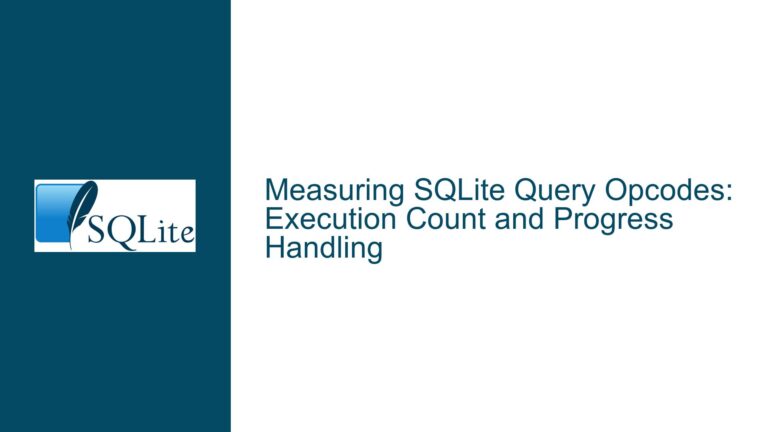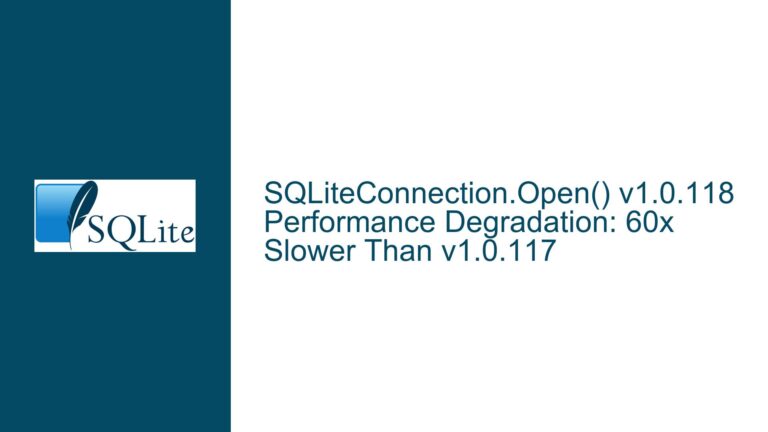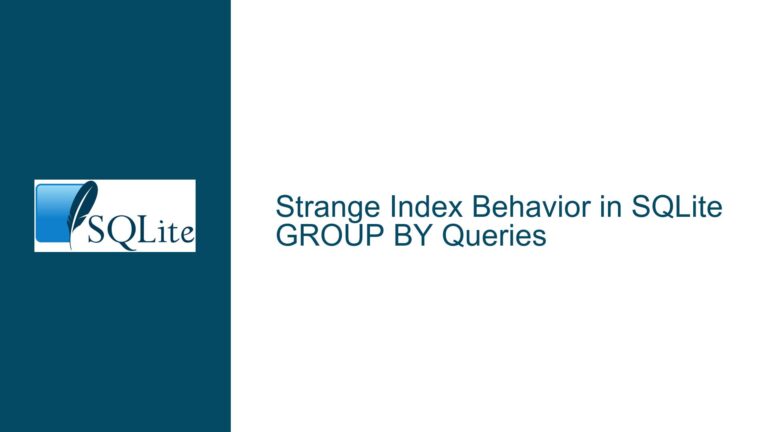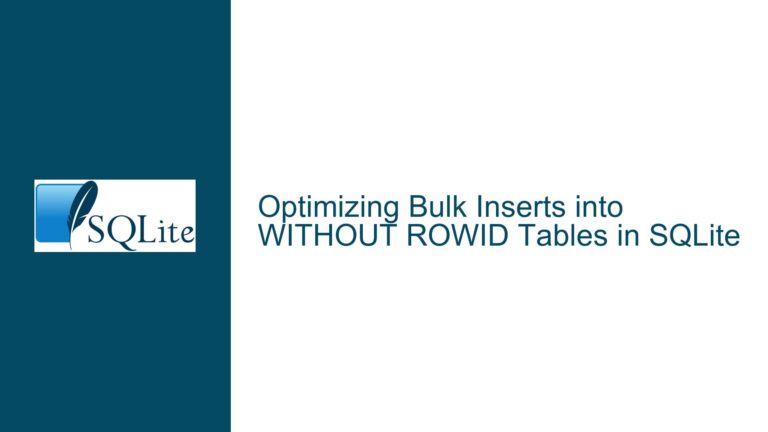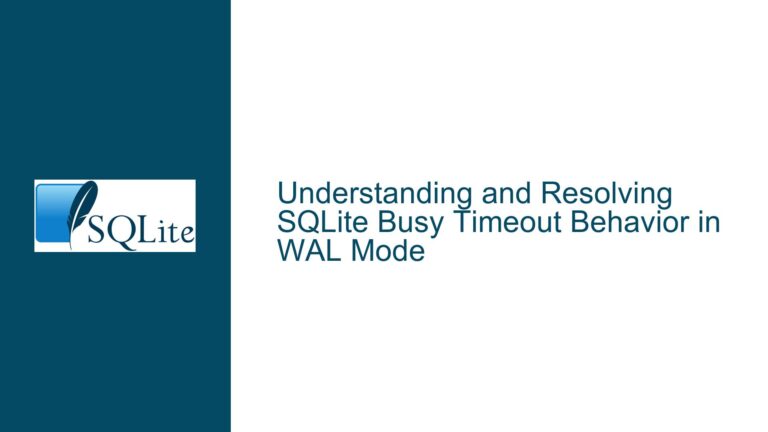SQLite Write Performance Disparity Across Windows and Linux: Transaction Scope and Disk Sync Dynamics
Transaction Handling and File System Sync Behavior in Cross-Platform SQLite Write Operations
Issue Overview: Transaction Isolation, Autocommit Overhead, and OS-Specific Disk Sync Enforcement
SQLite database write operations exhibit significant performance disparities between Windows and Linux environments when handling bulk data insertion tasks. A common scenario involves parsing a text file and inserting parsed records into a SQLite database, where Windows completes the task in 75 seconds while Linux requires 15 minutes. Profiling reveals that 90% of the execution time is consumed by database operations. The root cause lies in the interaction between SQLite’s transaction management logic, the operating system’s enforcement of disk synchronization commands, and the default configuration parameters governing write durability.
SQLite operates in autocommit mode by default, where every write operation (e.g., INSERT, UPDATE) is treated as an individual transaction. Each transaction triggers a full synchronization cycle to ensure data durability, which involves flushing writes to the physical disk medium. This design guarantees data integrity but incurs substantial I/O overhead. Windows and Linux differ in how they handle the fsync() system call—a low-level instruction that forces the operating system to flush buffered writes to disk. Windows often delays or ignores fsync() requests under certain configurations, prioritizing writeback caching for performance. Linux kernels, particularly when using ext4 or other journaling file systems, enforce fsync() rigorously, ensuring that all buffered data is written to disk before returning control to the application.
When bulk write operations are not explicitly wrapped in a transaction block (BEGIN TRANSACTION…COMMIT), SQLite issues an fsync() after every individual write in autocommit mode. On Linux, this results in thousands of synchronous disk writes, each waiting for physical storage acknowledgment. Windows’ lax enforcement of fsync() allows these operations to complete without waiting for disk confirmation, artificially accelerating write throughput at the expense of potential data loss during power failures or system crashes. The performance gap narrows dramatically when all writes are grouped into a single transaction, as SQLite synchronizes data only once at transaction commit.
Possible Causes: Autocommit Mode Penalty, Synchronous PRAGMA Settings, and File System Journaling Strategies
Autocommit Mode Overhead in Non-Transactional Workflows
SQLite’s default autocommit behavior treats each write operation as an independent transaction. This forces the database engine to:- Update the database file and associated journal files (rollback or Write-Ahead Log)
- Flush journal files to disk via
fsync()to guarantee crash consistency - Update the database file and flush again upon transaction completion
EveryINSERTstatement executed outside an explicit transaction triggers twofsync()calls (one for the journal, one for the main database) on Linux. Windows often skips these flushes due to differences in the file system driver stack, leading to faster but less durable writes.
Synchronous PRAGMA Configuration Mismatch
ThePRAGMA synchronousdirective controls how aggressively SQLite enforces disk synchronization. Valid modes include:FULL(default): Issuefsync()after critical phases of transaction commits, ensuring maximum durability.NORMAL: Omitfsync()during journal writes but retain it for the final database update.OFF: Disablefsync()entirely, relying on the operating system’s buffer cache.
Linux deployments often retain the defaultFULLmode, while Windows may effectively behave likeNORMALorOFFdue to filesystem semantics. This divergence amplifies performance differences when transactions are not batched.
File System Journaling and Write Barriers
Modern Linux file systems like ext4 employ metadata journaling and write barriers to preserve filesystem consistency. These features introduce additional synchronization points that interact with SQLite’s own journaling mechanism. For example, ext4’sdata=orderedmode (default) ensures file data is written to disk before associated metadata, forcing extra disk seeks. Windows’ NTFS lacks equivalent safeguards by default, trading durability for higher throughput.Disk Hardware and I/O Scheduler Differences
Linux I/O schedulers (e.g., CFQ, deadline, noop) prioritize fairness and latency over raw throughput for rotational disks. Coupled with slower HDDs, this can exacerbate transaction overhead. Windows’ I/O stack is optimized for desktop workloads, aggressively merging write requests and deferring disk synchronization.
Troubleshooting Steps, Solutions & Fixes: Transaction Batching, PRAGMA Tuning, and File System Optimization
1. Enclose All Write Operations in a Single Transaction
Explicit transaction blocks reduce the number of fsync() calls from one per write to one per transaction. Example:
# Python pseudocode
with sqlite3.connect('mydb.db') as conn:
cursor = conn.cursor()
cursor.execute("BEGIN TRANSACTION")
for record in parsed_data:
cursor.execute("INSERT INTO table VALUES (?, ?, ?)", record)
cursor.execute("COMMIT")
This ensures SQLite writes all changes to the journal file first, then updates the main database with a single fsync() at commit.
2. Adjust the Synchronous PRAGMA for Bulk Loads
Temporarily lowering the synchronization level during bulk inserts can accelerate writes while retaining transaction atomicity:
PRAGMA synchronous = OFF;
BEGIN TRANSACTION;
-- Bulk INSERTs here
COMMIT;
PRAGMA synchronous = FULL;
Caution: synchronous=OFF risks database corruption if the system crashes mid-transaction. Use only for recoverable data loads.
3. Switch to Write-Ahead Logging (WAL) Journal Mode
WAL mode (PRAGMA journal_mode=WAL;) separates writes into a dedicated log file, allowing readers to coexist with writers without locking. It reduces fsync() frequency by:
- Batching multiple transactions into a single log file update
- Using checkpointing to asynchronously merge the WAL into the main database
PRAGMA journal_mode=WAL;
PRAGMA wal_autocheckpoint=1000; -- Checkpoint after 1000 pages
4. Profile and Optimize File System Mount Options
On Linux, disable metadata journaling and enable writeback caching for the SQLite database directory:
# /etc/fstab entry for ext4
UUID=... /data ext4 noatime,nodiratime,data=writeback,discard 0 2
data=writeback: Journal metadata only, not file datanoatime: Skip access time updates on read operations
5. Monitor Disk I/O with Performance Tools
Use Linux utilities to identify I/O bottlenecks:
iostat -xmt 2: Monitor disk utilization and await timespidstat -d: Trace per-process disk activityftrace/perf: Profile kernel-levelfsync()latency
6. Prefer SSDs and Increase SQLite Cache Size
Solid-state drives mitigate random write penalties inherent in transactional databases. Scale SQLite’s memory cache to reduce disk hits:
PRAGMA cache_size = -100000; -- Allocate 100MB of page cache
7. Validate File System Alignment and Sector Size
Misaligned partitions or mismatched sector sizes between SQLite (default 4KB pages) and the disk (e.g., 512e emulation) degrade write throughput. Use fdisk to verify partition alignment and PRAGMA page_size to match the disk’s physical sector size.
8. Utilize Memory-Mapped I/O for Intermediate Data
For temporary tables or transient data, store the database in RAM using a :memory: URI or tmpfs mount:
conn = sqlite3.connect('file:/dev/shm/mydb.db?mode=memory&cache=shared', uri=True)
9. Disable Indexes and Triggers During Bulk Loads
Drop secondary indexes before bulk inserts and recreate them post-load:
DROP INDEX idx_column;
-- Perform INSERTs
CREATE INDEX idx_column ON table(column);
10. Benchmark Across File Systems and Kernel Versions
Test SQLite performance under XFS, Btrfs, and F2FS, which may offer better concurrency or reduced metadata overhead. Experiment with kernel versions ≥5.10, which include improved io_uring asynchronous I/O capabilities.
By systematically addressing transaction scope, synchronization semantics, and platform-specific I/O behavior, developers can harmonize SQLite write performance across Windows and Linux environments while maintaining data integrity guarantees.

